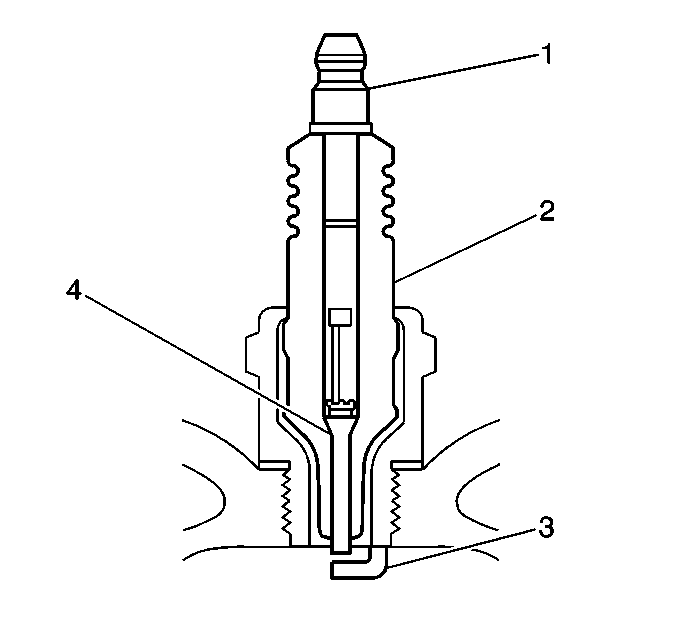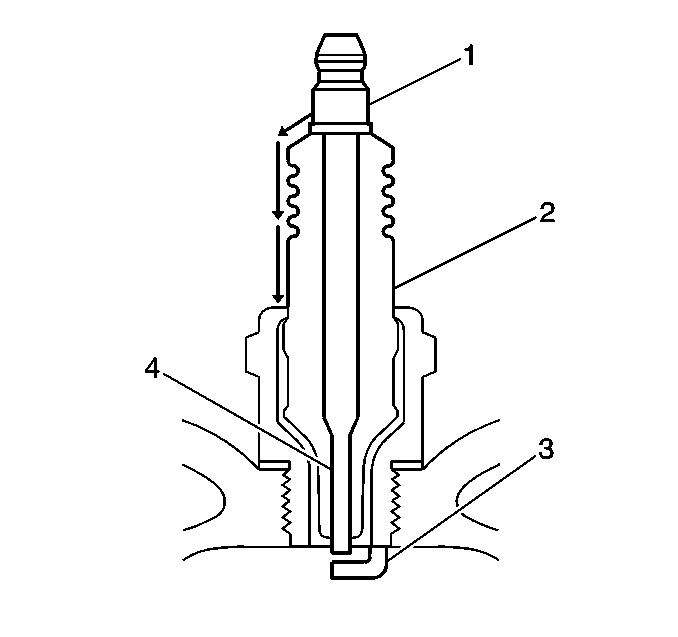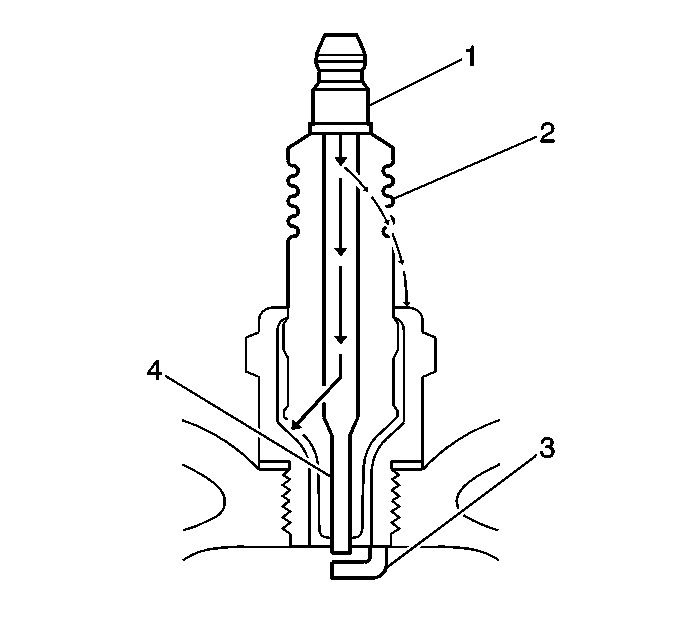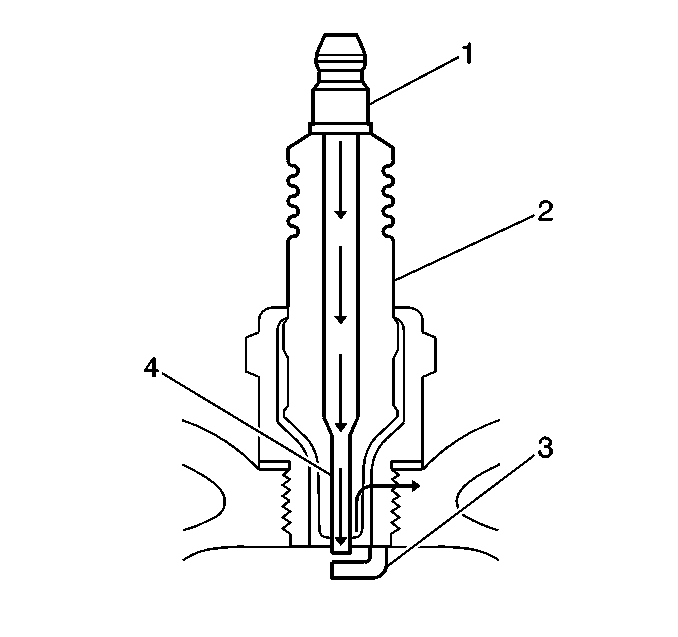For 1990-2009 cars only
Spark Plug Usage
| • | Ensure that the correct spark plug is installed. An incorrect spark plug causes driveability conditions. Refer to Ignition System Specifications for the correct spark plug. |
| • | Ensure that the spark plug has the correct heat range. An incorrect heat range causes the following conditions: |
| - | Spark plug fouling -- colder plug |
| - | Pre-ignition causing spark plug and/or engine damage -- hotter plug |
Spark Plug Inspection
| • |

|
| - | Inspect for a bent or broken terminal post (1). |
| - | Test for a loose terminal post (1) by twisting and pulling the post. The terminal post (1) should NOT move. |
| • |

|
| - | Inspect the spark plug boot for damage. |
| - | Inspect the spark plug recess area of the cylinder head for moisture, such as oil, coolant, or water. A spark plug boot that is saturated causes arcing to ground. |
| • |

|
| • |

|
| - | Measure the gap between the center electrode (4) and the side electrode (3) terminals. Refer to Spark Plug Inspection . An excessively wide electrode gap can prevent correct spark plug operation. |
| - | Inspect for signs of tracking that occurred near the insulator tip instead of the center electrode (4). |
| - | Inspect for a broken or worn side electrode (3). |
| - | Inspect for bridged electrodes (3, 4). Deposits on the electrodes (3, 4) reduce or eliminates the gap. |
| - | Inspect for worn or missing platinum pads on the electrodes (3, 4), If equipped. |
| - | Inspect for excessive fouling. |
Spark Plug Visual Inspection
| • | Normal Spark Plug Operation |
| - | Results in brown to grayish tan deposits on the area of the spark plug that enters the cylinder. |
| - | A small amount of reddish brown, yellow, and white powdery residue may also be present on the insulator tip around the center electrode. |
| - | These deposits are normal combustion by-product of fuels and lubricating oils which contain additives. |
| • | Carbon Fouling |
| - | Indicated by dry carbon deposits on the portion of the spark plug inside of the cylinder. |
| - | Excessive idling and driving at slower speeds under light engine loads can keep the spark plug temperatures so low that these deposits are not burned off. |
| - | Rich fuels or poor ignition system output may cause carbon fouling. |
| - | A spark plug of the incorrect heat range may cause carbon fouling. |
| - | Carbon deposits on the spark plug insulator tip may become conductive and cause the high voltage arc to track along the tip to some point where the high voltage arcs to join the spark plug shell. This arc ignites the air fuel mixture later than normal which, in effect, retards the ignition timing. |
| - | Heavy carbon deposits may be conductive to the extent that the arc path now becomes a shunt path to the spark plug shell, which prevents the spark from igniting the air/fuel mixture. |
| - | A power and fuel loss results. |
| - | The spark plug may be permanently damaged by arc tracking and must be replaced. |
| • | Oil Fouling |
| - | Oil fouling appears as wet oily deposits on the portion of the spark plug inside of the cylinder. |
| - | Oil getting past worn piston rings can leave oil deposits on the spark plug. |
| - | Breaking in a new or recently overhauled engine can sometimes leave oil deposits on spark plugs. |
| • | Deposit Fouling |
| - | Deposit fouling occurs when the normal reddish brown, yellow, or white deposits of combustion by-products become sufficient enough to cause misfiring. |
| - | In some cases, these deposits melt and form a shiny glaze on the insulator around the center electrode. |
| - | If the fouling is found only in one or two of the cylinders, valve stem clearances or the intake valve seals may be allowing excess lubricating oil to enter the cylinder, particularly if the deposits are heavier on the intake valve side of the spark plug. |
| • | Bridged Electrodes |
| - | Fouling deposits between the electrodes ground out the high voltage necessary to fire the spark plug. |
| - | The arc between electrode does not occur and the air fuel mixture is not ignited. |
| - | Fuel remains unburned and a power loss results. |
| • | Flashover |
| Flashover can occur when a damaged spark plug boot permits high voltage to short over the insulator to the spark plug shell or to the engine. Dirt, oil, and moisture may contribute to the formation of deposits that can lead to carbon tracking. Whenever a flashover occurs carbon is deposited allowing the arcing voltage to build a regular path to ground. |
| • | Excessive Gap |
| - | The air space between the center and side electrodes at the bottom of the spark plug is too wide for consistent firing. This may be due to improper gap adjustment or to excessive wear of the electrodes during use. |
| - | Excessive electrode wear on low mileage spark plugs may indicate vehicle operation at speeds higher than the speeds for which the engine was designed. |
| - | Excessive electrode wear on low mileage spark plugs may indicate that the spark plug's heat range is too high. |
| - | Electrode wear may also be the result of combustion gasses leaking past the spark plug threads. |
| - | Excessively lean fuel may also cause electrode wear. |
| - | Excessive electrode wear can prevent the high voltage from arcing across the electrodes. |
| - | Fuel remains unburned and a power loss results. |
| - | A gap that is too small may cause idling instability. |
| • | Incorrect Torque or Installation |
| - | Incorrect torque or seating can cause a spark plug to run hot. This can lead to excessive electrode wear and an incorrect gap. |
| - | In extreme cases, an over torqued or under torqued spark plug can cause exhaust blowby. The cylinder head seats must make good contact for sufficient heat transfer and spark plug cooling. |
| - | Dirty or damaged threads in the head or on the spark plug can keep the spark plug from seating even though the proper torque is applied. |
| - | Once the spark plugs are properly seated, tighten the spark plugs properly. |
| • | Cracked or Broken Insulators |
| - | Usually, cracked insulators or broken insulators are the result of incorrect installation or of heat shock. |
| - | Heat shock is a rapid increase in the insulator tip temperature which causes the insulator material to crack. |
| - | The upper insulators can be broken when a poorly-fitting tool is used during servicing, or when the spark plug is hit from the outside. |
| - | Cracks in the upper insulator may be inside the shell or invisible. |
| - | The breakage may not cause problems until oil or water penetrates the crack later. |
| - | A crack in the insulator causes the high voltage to ground out. The spark does not jump the electrode gap and the air fuel mixture is not ignited. |
| - | Fuel is unburned and power is lost. |
| - | Damage may result during gapping when the tool is pushed against the center electrode or the surrounding insulator, causing the insulator to crack. |
| - | Bend only the side electrode when gapping a spark plug. |
| • | Corona Discharge |
| - | Corona discharge is a steady blue light appearing around the insulator just above the shell crimp. |
| - | Corona discharge is the visible evidence of a high tension field and does not affect on ignition system performance. |
| - | The discharge may repel dust particles and leave a clear ring on the insulator just above the shell. |
| - | This ring is sometimes mistaken for evidence that combustion gasses have blown between the shell and the insulator. |
| - | Do not mistake corona discharge for flashover or for a shorted insulator. |
